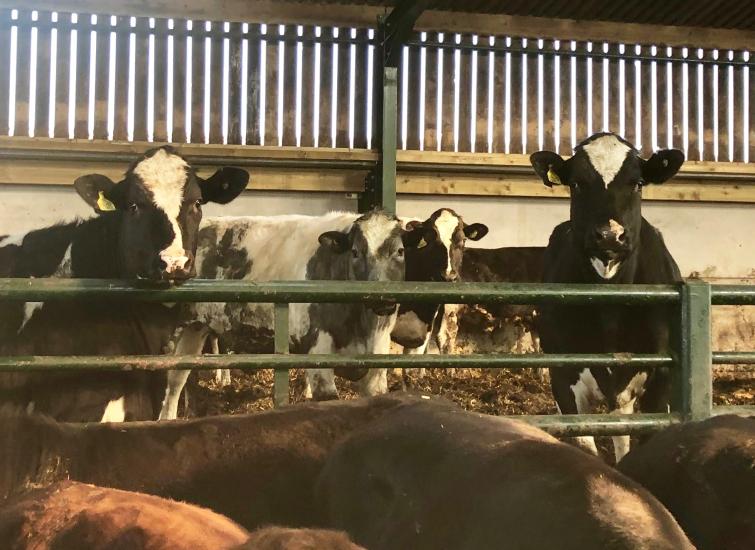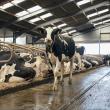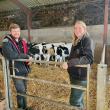Improving the quality of grass silage to add value
Improving the quality of grass silage adds value to the Holstein Beef Finishers at Moore Farm, Cheshire.

Richard Taylor from Advanced Nutrition has been working with Mr Jones at Moore Farm in Malpas Cheshire for the past two years. The farm is home to 100 Growers and 100 Fatteners on this semi-intensive farming system. The Holstein steers are part grazed during the spring and summer and housed for the rest of the year to grow and finish the cattle. The housed growers ration consists of grass silage, home-grown cereal, confectionary and a bespoke blend including minerals from Advanced Nutrition.
Mr Jones buys weanling calves, weighing at around 150-250Kg. They are put out to graze until they have grown to 450Kg, at which point they are housed with a growers ration until they reach optimum 550kg to then go onto the finishing stage, formulated by Richard.
In 2019, Mr Jones was keen to grow better quality grass silage, not only to improve the feed efficiency but to improve the health and fitness of the animals. Working together with Richard, they formulated a strategy to get the most out of his forage. In the spring of last year, Richard advised that the first cut be taken earlier than Mr Jones had done previously. Cutting the plant at a much younger maturity stage would achieve higher energy, protein, sugar and D value in the forage.
Prior to the first cut they also tested the grass silage to determine nitrate levels and also dry matter, protein and energy levels, allowing them to be precise in calculating the correct cutting and wilting time.
Richard comments, “Analysing the soil, the type of grass and timing of the cut were all important decisions in order to maximise the nutritional value of the forage. At the same time, we also needed to ensure that following ensilage, we protected that value with an additive. We treated the grass silage with Bonsilage Fit G. The additive takes control and shifts the fermentation pattern to produce sufficient acetic acid, which increases aerobic stability to stop the clamp face, (& TMR), from heating. As part of this process, propylene glycol is produced in significant quantities, optimising the energy properties of the grass silage which helps support the metabolism and health of the beef animals.”
This new focus on improving the quality of the grass silage has certainly worked.
Mr Jones comments, “When we analysed the first cut to feed this winter we saw an extra 1MJ of energy from 10.4ME to an increase of 11.5ME which is an increase in D value of 11%. The animals also looked really well, with a shine to their coats and clearly looked very fit. The TMR mix kept stable and total intakes were maximised”
The housed growers were weighed and had achieved a 1.7Kg DLWG from 450Kg to 550Kg liveweight in 60 days of feeding. Animals were consuming a total 9.4kg DMI/day giving a feed conversion ratio, (FCR kg DMI/kg LWG) of 5.52.
Mr Jones also noted a reduction in antibiotic usage. Rumination was improved and less symptoms of SARA were observed. For the farm, this meant a significant reduction in costs, not just from the veterinary side but through reducing the amount of purchased blend in the growing ration. They also increased the forage to concentrate ratio to drive homegrown cereal too.
Impact of silage quality on concentrate levels
Mr Jones comments, “Going from a moderate grass silage quality of 10.5 ME to a 11.5ME we have been able to reduce purchased blend concentrates by 1.25kg per head/day and increase forage intake. We have gone from a 62% Concentrate: 38% Forage ration to a 50% Concentrate: 50% Forage Ration. Working on the cost of concentrate for the housed growing cattle through to slaughter; over a winter period of 150 days, it has saved £40/head on purchased concentrate costs.
Plans for the future
Mr Jones is keen to keep improving efficiencies on farm. The team are now looking to increase meat from grazing with higher quality grazing grass. Better grazing utilisation will be achieved by keeping the grazed plant young and to reduce wastage. They are also looking at growing additional protein feeds such as beans and peas to reduce purchased protein costs and to fix valuable nitrogen back into ground and fit well in the rotation of grass and cereals. Other high starch and NDF forages are being evaluated. For example, wholecrop for additional starch and NDF value to feed well with the high quality grass silage, reducing the need to feed straw. It would also enable a valuable starch source in the clamp to help control the rising feed costs on cereals for the future and in turn increase forage to concentrate in the rations.
〈 BACK














